Spatial Pattern of Land Use Change and Its Driving Force in Jiangsu Province
Abstract
:1. Introduction
2. Study Area and Methodology
2.1. Study Area
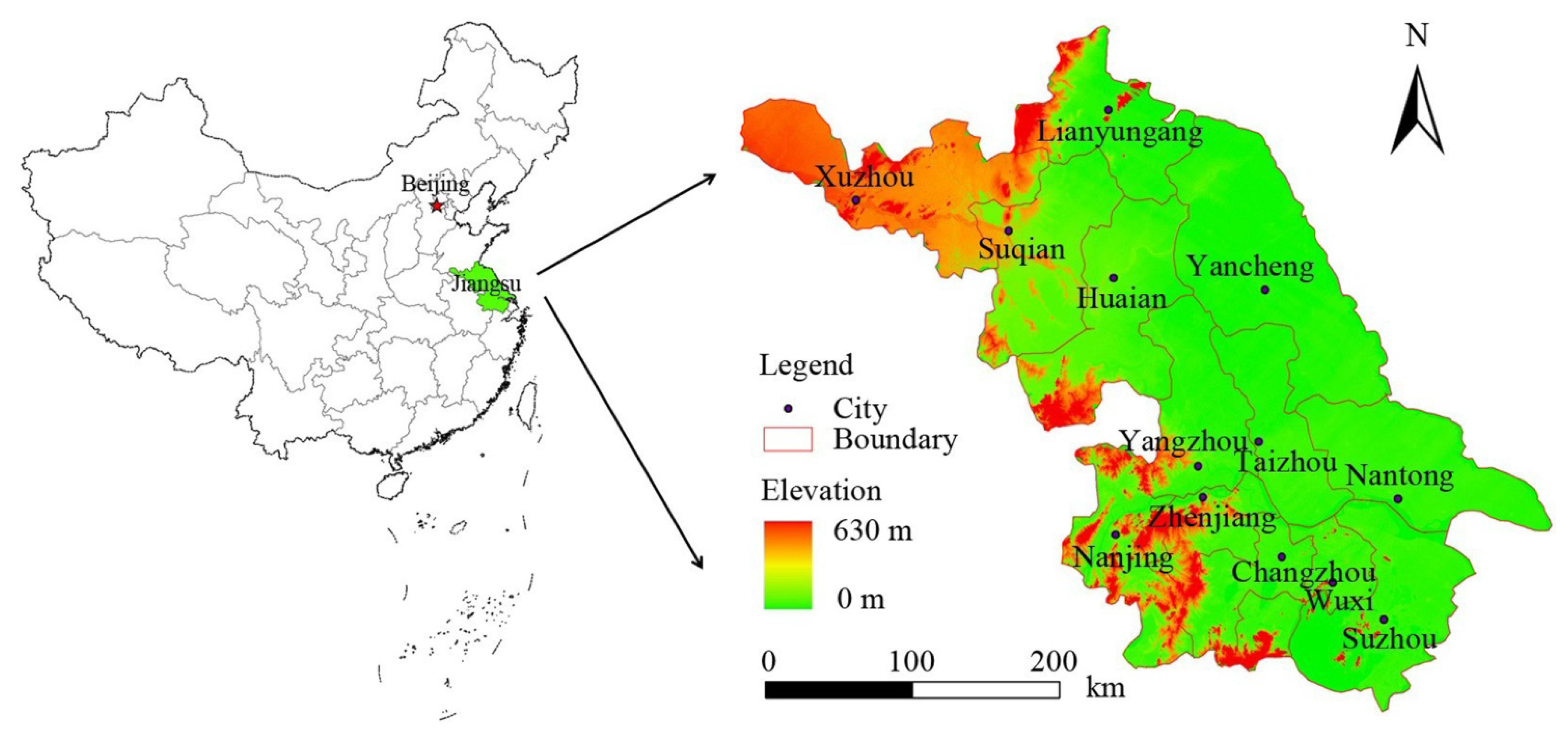
2.2. Data Source
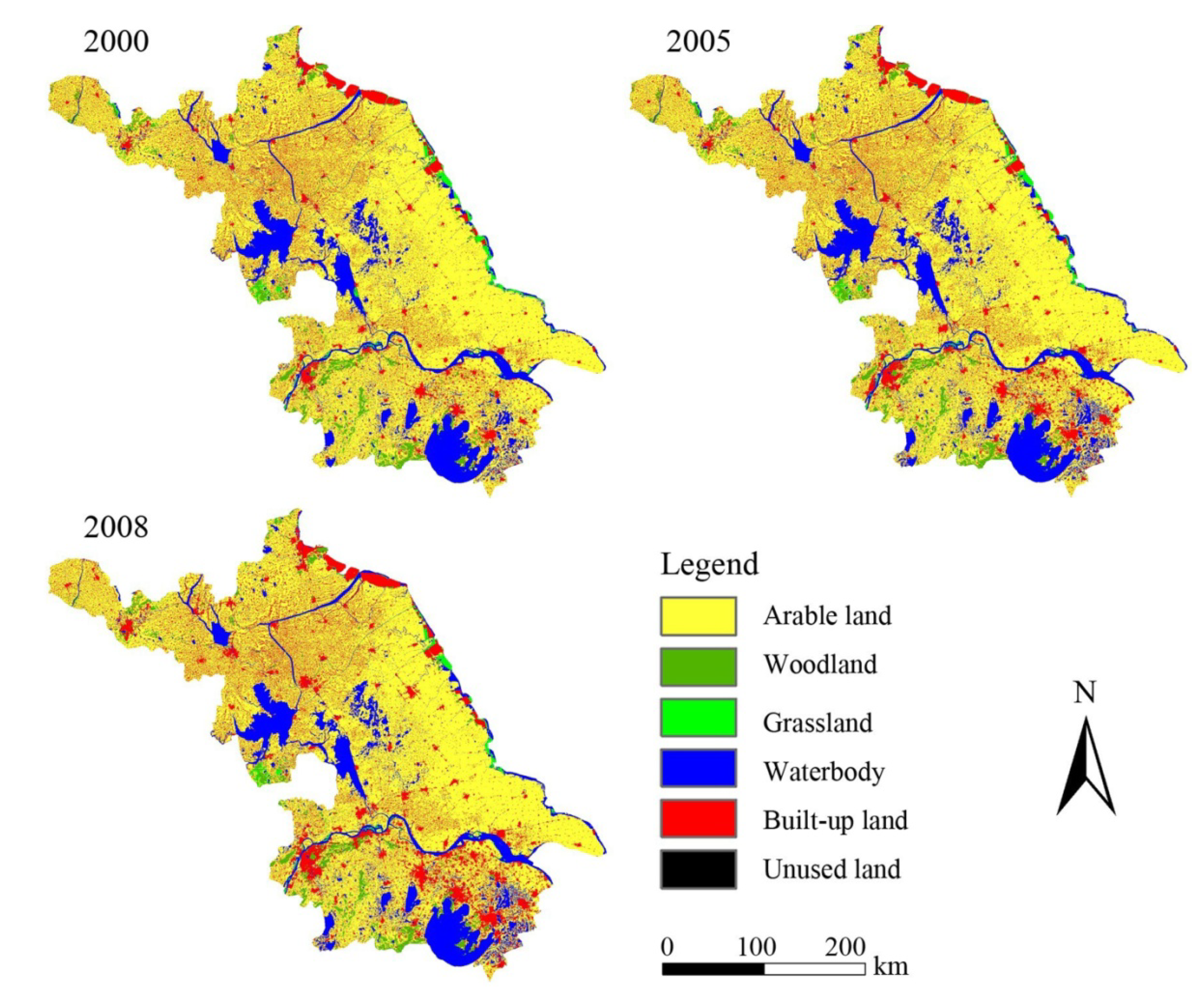
| Driven factor | Description |
|---|---|
| RP | People residing in a single location for more than 12 months; represents population pressure (unit: 104) |
| UP | People residing in urban area for more than 12 months; represents urbanization level (unit: 104) |
| POD | Resident population per unit area; represents population pressure (unit: /km2) |
| GDP | Represents economic development level (unit: 109 yuan) |
| SGDP | Represents economic development and industrialization level (unit: 109 yuan) |
| TGDP | Represents economic industrialization level (unit: 109 yuan) |
| PerGDP | Represents economic development level (unit: yuan) |
| FAI | Represents capabilityof fixed assets investment (unit: 109 yuan) |
| FI | Represents capability of improve living conditions of urban residents (unit: yuan) |
| UI | Represents capability of improving living conditions of farmers (unit: yuan) |
2.3. Land Use Dynamics

2.4. Spatial Pattern Changes
2.5. Driving Force Analysis
3. Results and Discussion
3.1. Land Use Change

| 2000 | 2005 | ||||||
|---|---|---|---|---|---|---|---|
| Cropland | Woodland | Grassland | Water body | Built-up land | Unused land | Total area | |
| Cropland | 6,722,875 | 4,757 | 313 | 61,228 | 119,333 | 132 | 6,908,638 |
| Woodland | 2,822 | 313,618 | 43 | 356 | 1,265 | 17 | 318,121 |
| Grassland | 4,259 | 114 | 94,950 | 16,066 | 1,807 | 1 | 117,197 |
| Water body | 12,531 | 230 | 1,211 | 1,233,936 | 5,715 | 6 | 1,253,629 |
| Built-up land | 41,955 | 835 | 232 | 3,851 | 1,401,531 | 6 | 1,448,410 |
| Unused land | 3 | 26 | 1 | 137 | 1 | 1,630 | 1,798 |
| Total | 6,784,445 | 319,580 | 96,750 | 1,315,574 | 1,529,652 | 1,792 | 10,047,793 |
| 2005 | 2008 | ||||||
|---|---|---|---|---|---|---|---|
| Cropland | Woodland | Grassland | Water Body | Built-Up Land | Unused Land | Total Area | |
| Cropland | 6,550,984 | 2,842 | 777 | 11,966 | 217,841 | 35 | 6,784,445 |
| Woodland | 11,585 | 301,778 | 2 | 165 | 6,026 | 24 | 319,580 |
| Grassland | 5,766 | 83 | 80,111 | 5,559 | 5,231 | - | 96,750 |
| Water body | 3,562 | 108 | 756 | 1,302,762 | 8,386 | - | 1,315,574 |
| Built-up land | 13,924 | 821 | 10 | 1,106 | 1,513,754 | 37 | 1,529,652 |
| Unused land | 2 | 60 | - | - | 161 | 1,569 | 1,792 |
| Total area | 6,585,823 | 305,692 | 81,656 | 1,321,558 | 1,751,399 | 1,665 | 10,047,793 |
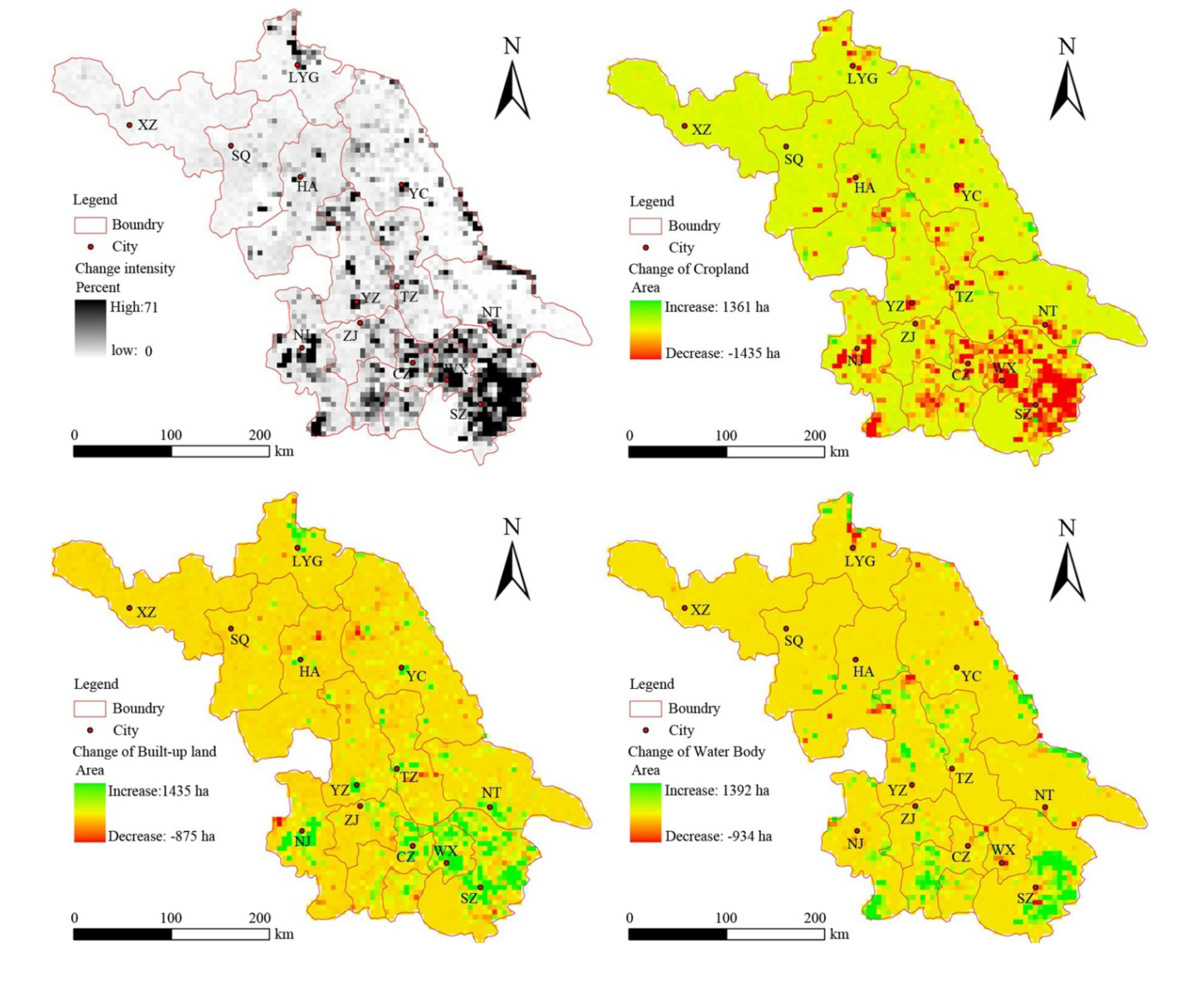
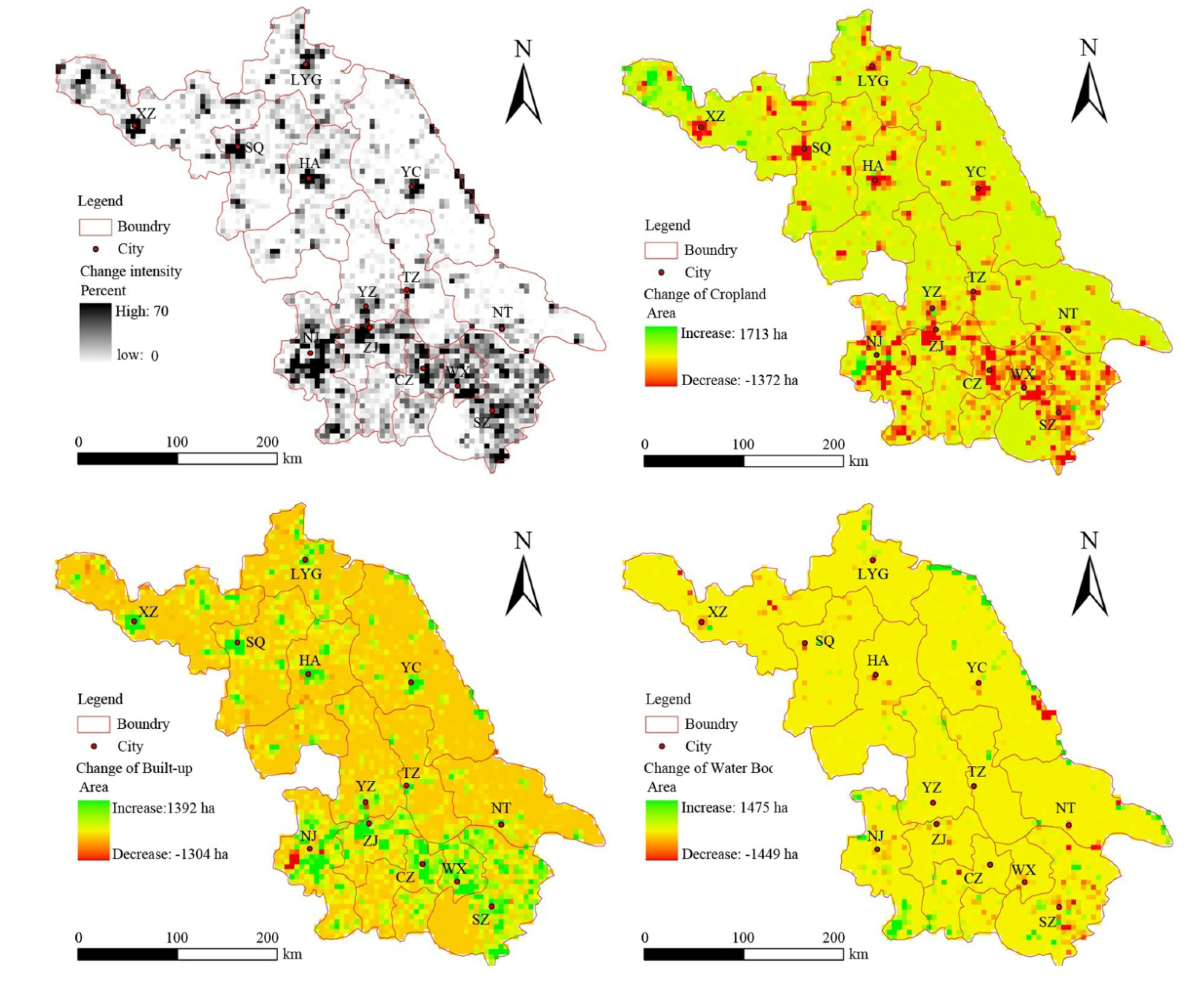
| Land use type | NumP | MPS (ha) | PSSD | MSI | ||||||||
|---|---|---|---|---|---|---|---|---|---|---|---|---|
| 2000 | 2005 | 2008 | 2000 | 2005 | 2008 | 2000 | 2005 | 2008 | 2000 | 2005 | 2008 | |
| 1 | 6,008 | 4,795 | 5,222 | 1,149.91 | 1,414.90 | 1,261.17 | 47,973.6 | 52,481.7 | 48,878.3 | 1.427 | 1.487 | 1.501 |
| 2 | 3,835 | 3,587 | 3,393 | 82.95 | 89.09 | 90.09 | 552.1 | 573.2 | 539.8 | 1.461 | 1.460 | 1.461 |
| 3 | 1,245 | 1,124 | 1,154 | 94.13 | 86.08 | 70.76 | 569.2 | 478.0 | 414.8 | 1.510 | 1.513 | 1.498 |
| 4 | 14,398 | 13,828 | 13,590 | 87.07 | 95.14 | 97.24 | 4,650.5 | 4,757.5 | 4,839.6 | 1.385 | 1.391 | 1.391 |
| 5 | 66,921 | 61,471 | 58,193 | 21.64 | 24.78 | 30.92 | 203.9 | 264.6 | 365.5 | 1.379 | 1.375 | 1.380 |
| 6 | 118 | 116 | 100 | 15.24 | 15.45 | 16.65 | 31.5 | 29.7 | 31.4 | 1.364 | 1.364 | 1.365 |
3.2. Driving Factors
3.2.1. Socio-Economic Development
| Factor | BL | RP | UP | POD | GDP | SGDP | TGDP | PerGDP | FAI | UI | FI |
|---|---|---|---|---|---|---|---|---|---|---|---|
| BL | 1 | ||||||||||
| RP | 0.847 ** | 1 | |||||||||
| UP | 0.830 ** | 0.645 ** | 1 | ||||||||
| POD | 0.762 ** | 0.967 ** | 0.574 ** | 1 | |||||||
| GDP | 0.967 ** | 0.864 ** | 0.858 ** | 0.785 ** | 1 | ||||||
| SGDP | 0.975 ** | 0.814 ** | 0.840 ** | 0.721 ** | 0.987 ** | 1 | |||||
| TGDP | 0.879 ** | 0.914 ** | 0.810 ** | 0.872 ** | 0.946 ** | 0.883 ** | 1 | ||||
| PerGDP | 0.980 ** | 0.882 ** | 0.710 ** | 0.858 ** | 0.940 ** | 0.932 ** | 0.896 ** | 1 | |||
| FAI | 0.876 ** | 0.964 ** | 0.759 ** | 0.925 ** | 0.919 ** | 0.859 ** | 0.971 ** | 0.886 ** | 1 | ||
| UI | 0.796 ** | 0.889 ** | 0.633 * | 0.913 ** | 0.846 ** | 0.802 ** | 0.883 ** | 0.937 ** | 0.893 ** | 1 | |
| FI | 0.837 ** | 0.833 ** | 0.605 * | 0.848 ** | 0.838 ** | 0.833 ** | 0.800 ** | 0.943 ** | 0.825 ** | 0.957 ** | 1 |
| Factor | BL | RP | UP | POD | GDP | SGDP | TGDP | PerGDP | FAI | UI | FI |
|---|---|---|---|---|---|---|---|---|---|---|---|
| BL | 1 | ||||||||||
| RP | 0.905 ** | 1 | |||||||||
| UP | 0.847 ** | 0.880 ** | 1 | ||||||||
| POD | 0.890 ** | 0.974 ** | 0.828 ** | 1 | |||||||
| GDP | 0.824 ** | 0.918 ** | 0.886 ** | 0.906 ** | 1 | ||||||
| SGDP | 0.786 ** | 0.891 ** | 0.840 ** | 0.869 ** | 0.992 ** | 1 | |||||
| TGDP | 0.851 ** | 0.938 ** | 0.918 ** | 0.940 ** | 0.987 ** | 0.959 ** | 1 | ||||
| PerGDP | 0.520 | 0.712 ** | 0.481 | 0.780 ** | 0.768 ** | 0.772 ** | 0.761 ** | 1 | |||
| FAI | 0.674 * | 0.694 ** | 0.875 ** | 0.698 ** | 0.814 ** | 0.778 ** | 0.828 ** | 0.433 | 1 | ||
| UI | 0.653 * | 0.804 ** | 0.608 * | 0.847 ** | 0.759 ** | 0.735 ** | 0.789 ** | 0.915 ** | 0.428 | 1 | |
| FI | 0.631 * | 0.768 ** | 0.533 | 0.844 ** | 0.782 ** | 0.776 ** | 0.787 ** | 0.972 ** | 0.475 | 0.942 ** | 1 |
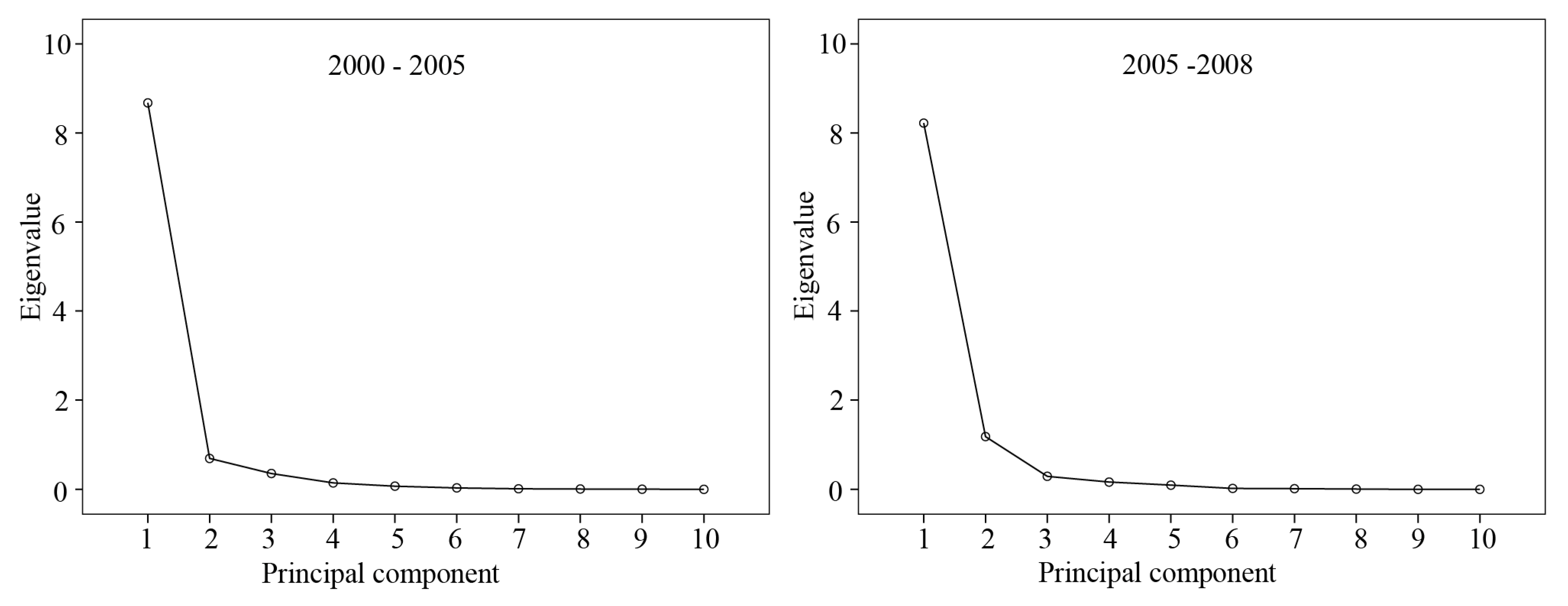
| Period | βPC1 | βPC2 | PPC1 | PPC2 | DE (%) |
|---|---|---|---|---|---|
| 2000–2005 | 0.932 | 0.219 | 0.00 | 0.04 | 91.60 |
| 2005–2008 | 0.841 | - | 0.00 | - | 81.04 |
| Period | RP | UP | PoD | GDP | SGDP | TGDP | PerGDP | FAI | UI | FI |
|---|---|---|---|---|---|---|---|---|---|---|
| 2000–2005 | 0.247 | 0.396 | 0.200 | 0.365 | 0.366 | 0.326 | 0.295 | 0.297 | 0.235 | 0.234 |
| 2005–2008 | 0.440 | 0.341 | 0.399 | 0.232 | 0.194 | 0.283 | 0.130 | 0.074 | 0.328 | 0.197 |
3.2.2. Policies
4. Conclusions
Acknowledgments
Author Contributions
Conflicts of Interest
References
- Foley, J.A.; DeFries, R.; Asner, G.P.; Barford, C.; Bonan, G.; Carpenter, S.R.; Chapin, F.S.; Coe, M.T.; Daily, G.C.; Gibbs, H.K.; et al. Global consequences of land use. Science 2005, 309, 570–574. [Google Scholar]
- King, R.S.; Baker, M.E.; Whigham, D.F.; Weller, D.E.; Jordan, T.E.; Kazyak, P.F.; Hurd, M.K. Spatial considerations for linking watershed land cover to ecological indicators in streams. Ecol. Appl. 2005, 15, 137–153. [Google Scholar] [CrossRef]
- Ramankutty, N.; Foley, J.A. Characterizing patterns of global land use: An analysis of global croplands data. Glob. Biogeochem. Cycles 1998, 12, 667–685. [Google Scholar] [CrossRef]
- Santini, M.; Valentini, R. Predicting hot-spots of land use changes in Italy by ensemble forecasting. Reg. Environ. Chang. 2011, 11, 483–502. [Google Scholar] [CrossRef]
- Falcucci, A.; Maiorano, L.; Boitani, L. Changes in land-use/land-cover patterns in Italy and their implications for biodiversity conservation. Landsc. Ecol. 2007, 22, 617–631. [Google Scholar] [CrossRef]
- Brown, D.G.; Johnson, K.M.; Loveland, T.R.; Theobald, D.M. Rural land-use trends in the conterminous United States, 1950–2000. Ecol. Appl. 2005, 15, 1851–1863. [Google Scholar] [CrossRef]
- Munroe, D.K.; Southworth, J.; Tucker, C.M. The dynamics of land-cover change in western Honduras: Exploring spatial and temporal complexity. Agric. Econ. 2002, 27, 355–369. [Google Scholar] [CrossRef]
- Fox, J.; Vogler, J.B. Land-use and land-cover change in montane mainland southeast Asia. Environ. Manag. 2005, 36, 394–403. [Google Scholar] [CrossRef]
- Brinkmann, K.; Schumacher, J.; Dittrich, A.; Kadaore, I.; Buerkert, A. Analysis of landscape transformation processes in and around four West African cities over the last 50 years. Landsc. Urban Plan 2012, 105, 94–105. [Google Scholar] [CrossRef]
- Fukushima, T.; Takahashi, M.; Matsushita, B.; Okanishi, Y. Land use/cover change and its drivers: A case in the watershed of Lake Kasumigaura, Japan. Landsc. Ecol. Eng. 2007, 3, 21–31. [Google Scholar] [CrossRef]
- Dewan, A.M.; Yamaguchi, Y. Land use and land cover change in Greater Dhaka, Bangladesh: Using remote sensing to promote sustainable urbanization. Appl. Geogr. 2009, 29, 390–401. [Google Scholar] [CrossRef]
- Dewan, A.M.; Yamaguchi, Y.; Rahman, M.Z. Dynamics of land use/cover changes and the analysis of landscape fragmentation in Dhaka Metropolitan, Bangladesh. GeoJournal 2012, 77, 315–330. [Google Scholar] [CrossRef]
- Bolstad, P.; Lillesand, T.M. Rapid maximum likelihood classification. Photogramm. Eng. Remote Sens. 1991, 57, 67–74. [Google Scholar]
- Dewan, A.M.; Yamaguchi, Y. Using remote sensing and GIS to detect and monitor land use and land cover change in Dhaka Metropolitan of Bangladesh during 1960–2005. Environ. Monit. Assess. 2009, 150, 237–249. [Google Scholar] [CrossRef]
- Braimoh, A.K.; Onishi, T. Spatial determinants of urban land use change in Lagos, Nigeria. Land Use Policy 2007, 24, 502–515. [Google Scholar] [CrossRef]
- Jat, M.K.; Garg, P.K.; Khare, D. Monitoring and modelling of urban sprawl using remote sensing and GIS techniques. Int. J. Appl. Earth Obs. Geoinf. 2008, 10, 26–43. [Google Scholar] [CrossRef]
- Kamusoko, C.; Aniya, M.; Adi, B.; Manjoro, M. Rural sustainability under threat in Zimbabwe—Simulation of future land use/cover changes in the Bindura district based on the Markov-cellular automata model. Appl. Geogr. 2009, 29, 435–447. [Google Scholar] [CrossRef]
- Dewan, A.M.; Kabir, M.H.; Nahar, K.; Rahman, M.Z. Urbanisation and environmental degradation in Dhaka Metropolitan Area of Bangladesh. Int. J. Environ. Sustain. Dev. 2012, 11, 118–147. [Google Scholar] [CrossRef]
- Wang, J.; Chen, Y.; Shao, X.; Zhang, Y.; Cao, Y. Land-use changes and policy dimension driving forces in China: Present, trend and future. Land Use Policy 2012, 29, 737–749. [Google Scholar] [CrossRef]
- Liu, J.Y.; Liu, M.L.; Tian, H.Q.; Zhuang, D.F.; Zhang, Z.X.; Zhang, W.; Tang, X.M.; Deng, X.Z. Spatial and temporal patterns of China’s cropland during 1990–2000: An analysis based on Landsat TM data. Remote Sens. Environ. 2005, 98, 442–456. [Google Scholar] [CrossRef]
- Liu, Y.S.; Wang, L.J.; Long, H.L. Spatio-temporal analysis of land-use conversion in the eastern coastal China during 1996–2005. J. Geogr. Sci. 2008, 18, 274–282. [Google Scholar] [CrossRef]
- Deng, X.Z.; Huang, J.K.; Rozelle, S.; Uchida, E. Economic growth and the expansion of urban land in China. Urban Stud. 2010, 47, 813–843. [Google Scholar] [CrossRef]
- Liu, J.Y.; Liu, M.L.; Zhuang, D.F.; Zhang, Z.X.; Deng, X.Z. Study on spatial pattern of land-use change in China during 1995–2000. Sci. China Ser. D Earth Sci. 2003, 46, 373–384. [Google Scholar] [CrossRef]
- Liu, J.Y.; Zhan, J.Y.; Deng, X.Z. Spatio-temporal patterns and driving forces of urban land expansion in china during the economic reform era. Ambio 2005, 34, 450–455. [Google Scholar]
- Liu, J.Y.; Zhang, Q.; Hu, Y.F. Regional differences of China’s urban expansion from late 20th to early 21st century based on remote sensing information. Chin. Geogr. Sci. 2012, 22, 1–14. [Google Scholar] [CrossRef]
- Shi, Y.; Xiao, J.; Shen, Y.; Yamaguchi, Y. Quantifying the spatial differences of landscape change in the Hai River Basin, China, in the 1990s. Int. J. Remote Sens. 2012, 33, 4482–4501. [Google Scholar] [CrossRef]
- Xiao, J.; Shen, Y.; Ge, J.; Tateishi, R.; Tang, C.; Liang, Y.; Huang, Z. Evaluating urban expansion and land use change in Shijiazhuang, China, by using GIS and remote sensing. Landsc. Urban Plan 2006, 75, 69–80. [Google Scholar] [CrossRef]
- Su, W.Z.; Gu, C.L.; Yang, G.S.; Chen, S.; Zhen, F. Measuring the impact of urban sprawl on natural landscape pattern of the Western Taihu Lake watershed, China. Landsc. Urban Plan 2010, 95, 61–67. [Google Scholar] [CrossRef]
- Wang, S.Y.; Liu, J.S.; Ma, T.B. Dynamics and changes in spatial patterns of land use in Yellow River Basin, China. Land Use Policy 2010, 27, 313–323. [Google Scholar] [CrossRef]
- Tian, G.J.; Jiang, J.; Yang, Z.F.; Zhang, Y.Q. The urban growth, size distribution and spatio-temporal dynamic pattern of the Yangtze River Delta megalopolitan region, China. Ecol. Model. 2011, 222, 865–878. [Google Scholar] [CrossRef]
- Long, H.L.; Tang, G.P.; Li, X.B.; Heilig, G.K. Socio-economic driving forces of land-use change in Kunshan, the Yangtze River Delta economic area of China. J. Environ. Manag. 2007, 83, 351–364. [Google Scholar] [CrossRef]
- Tan, M.H.; Li, X.B.; Xie, H.; Lu, C.H. Urban land expansion and arable land loss in China—A case study of Beijing-Tianjin-Hebei region. Land Use Policy 2005, 22, 187–196. [Google Scholar] [CrossRef]
- Long, H.L.; Liu, Y.S.; Wu, X.Q.; Dong, G.H. Spatio-temporal dynamic patterns of farmland and rural settlements in Su-Xi-Chang region: Implications for building a new countryside in coastal China. Land Use Policy 2009, 26, 322–333. [Google Scholar] [CrossRef]
- Wu, K.; Zhang, H. Land use dynamics, built-up land expansion patterns, and driving forces analysis of the fast-growing Hangzhou metropolitan area, eastern China (1978–2008). Appl. Geogr. 2012, 34, 137–145. [Google Scholar] [CrossRef]
- Lin, G.; Ho, S. China’s land resources and land-use change: Insights from the 1996 land survey. Land Use Policy 2003, 20, 87–107. [Google Scholar] [CrossRef]
- Gao, J.; Liu, Y.S. Climate warming and land use change in Heilongjiang Province, Northeast China. Appl. Geogr. 2011, 31, 476–482. [Google Scholar] [CrossRef]
- Zhang, Y.; Gong, H.; Zhao, W.; Li, X. Analyzing the mechanism of land use change in Beijing City from 1990 to 2000. Resour. Sci. 2007, 29, 206–213. [Google Scholar]
- Wang, X.H.; Bennett, J.; Xu, J.T.; Zhang, H.P. An auction scheme for land use change in Sichuan Province, China. J. Environ. Plan. Manag. 2012, 55, 1269–1288. [Google Scholar] [CrossRef]
- Zheng, Z.; Yang, W.; Zhou, G.; Wang, X. Analysis of land use and cover change in Sichuan province, China. J. Appl. Remote Sens. 2012, 6. [Google Scholar] [CrossRef]
- Zhan, J.Y.; Shi, N.N.; He, S.J.; Lin, Y.Z. Factors and mechanism driving the land-use conversion in Jiangxi Province. J. Geogr. Sci. 2010, 20, 525–539. [Google Scholar] [CrossRef]
- Chen, J.; Wei, S.; Chang, K.; Tsai, B. A comparative case study of cultivated land changes in Fujian and Taiwan. Land Use Policy 2007, 24, 386–395. [Google Scholar] [CrossRef]
- Xia, R.; Li, Y.; Wang, Q.; Xu, E.; Wang, X.; Wang, Y. Response relationship between land-use and transit water quality in Wuxi City based on remote sensing. Sci. Geogr. Sin. 2010, 30, 129–133. [Google Scholar]
- Ou, W.; Yang, G.; Yu, X.; Li, H. Effect of coastal land use changes on eco-environment in the coastal zone of Yancheng. Resour. Sci. 2004, 26, 76–83. [Google Scholar]
- Chen, L.; Wang, Y.M.; Li, P.W.; Ji, Y.Q.; Kong, S.F.; Li, Z.Y.; Bai, Z.P. A land use regression model incorporating data on industrial point source pollution. J. Environ. Sci.-China 2012, 24, 1251–1258. [Google Scholar] [CrossRef]
- Hao, H.T.; Sun, B.; Zhao, Z.H. Effect of land use change from paddy to vegetable field on the residues of organochlorine pesticides in soils. Environ. Pollut. 2008, 156, 1046–1052. [Google Scholar] [CrossRef]
- Fu, B.J.; Chen, L.D.; Wang, J.; Meng, Q.H.; Zhao, W.W. Land use structure and ecological process. Quat. Sci. 2003, 23, 247–255. [Google Scholar]
- Griffith, J.A.; Martinko, E.A.; Price, K.P. Landscape structure analysis of Kansas at three scales. Landsc. Urban Plan 2000, 52, 45–61. [Google Scholar] [CrossRef]
- Herold, M.; Scepan, J.; Clarke, K.C. The use of remote sensing and landscape metrics to describe structures and changes in urban land uses. Environ. Plan. A 2002, 34, 1443–1458. [Google Scholar] [CrossRef]
- Gong, C.; Yu, S.; Joesting, H.; Chen, J. Determining socioeconomic drivers of urban forest fragmentation with historical remote sensing images. Landsc. Urban Plan 2013, 117, 57–65. [Google Scholar] [CrossRef]
- Armenteras, D.; Rodríguez, N.; Retana, J.; Morales, M. Understanding deforestation in montane and lowland forests of the Colombian Andes. Reg. Environ. Chang. 2011, 11, 693–705. [Google Scholar] [CrossRef]
- Liu, J.Y.; Deng, X.Z. Progress of the research methodologies on the temporal and spatial process of LUCC. Chin. Sci. Bull. 2010, 55, 1354–1362. [Google Scholar] [CrossRef]
- Nagendra, H.; Munroe, D.K.; Southworth, J. From pattern to process: Landscape fragmentation and the analysis of land use/land cover change. Agric. Ecosyst. Environ. 2004, 101, 111–115. [Google Scholar] [CrossRef]
- Wei, Y.P.; Zhang, Z.Y. Assessing the fragmentation of construction land in urban areas: An index method and case study in Shunde, China. Land Use Policy 2012, 29, 417–428. [Google Scholar] [CrossRef]
- Xie, Y.; Yu, M.; Tian, G.; Xing, X. Socio-economic driving forces of arable land conversion: A case study of Wuxian City, China. Glob. Environ. Chang. 2005, 15, 238–252. [Google Scholar] [CrossRef]
- Quan, B.; Chen, J.F.; Qiu, H.L.; Romkens, M.; Yang, X.Q.; Jiang, S.F.; Li, B.C. Spatial-temporal pattern and driving forces of land use changes in Xiamen. Pedosphere 2006, 16, 477–488. [Google Scholar] [CrossRef]
- Turner, B.L.; Meyer, W.B.; Skole, D.L. Global land-use land-cover change—Towards an integrated study. Ambio 1994, 23, 91–95. [Google Scholar]
- Lo, C.P.; Yang, X.J. Drivers of land-use/land-cover changes and dynamic modeling for the Atlanta, Georgia Metropolitan area. Photogramm. Eng. Remote Sens. 2002, 68, 1073–1082. [Google Scholar]
- Bai, X.M.; Chen, J.; Shi, P.J. Landscape urbanization and economic growth in China: Positive feedbacks and sustainability dilemmas. Environ. Sci. Technol. 2012, 46, 132–139. [Google Scholar] [CrossRef]
- Xie, Y.C.; Fang, C.L.; Lin, G.; Gong, H.M.; Qiao, B. Tempo-spatial patterns of land use changes and urban development in globalizing China: A study of Beijing. Sensors 2007, 7, 2881–2906. [Google Scholar] [CrossRef]
- Ameztegui, A.; Brotons, L.; Coll, L. Land-use changes as major drivers of mountain pine (Pinus uncinata Ram.) expansion in the Pyrenees. Glob. Ecol. Biogeogr. 2010, 19, 632–641. [Google Scholar]
- Overmars, K.P.; Verburg, P.H. Analysis of land use drivers at the watershed and household level: Linking two paradigms at the Philippine forest fringe. Int. J. Geogr. Inf. Sci. 2005, 19, 125–152. [Google Scholar] [CrossRef]
- Priess, J.A.; Mimler, M.; Weber, R.; Faust, H. Socio-Environmental Impacts of Land Use and Land Cover Change at a Tropical Forest Frontier. In Modsim 2007: International Congress on Modelling and Simulation: Land Water and Environmental Management: Integrated Systems for Sustainability; Modelling & Simulation Soc Australia & New Zealand Inc.: Christchurch, New Zealand, 2007; pp. 349–357. [Google Scholar]
- Kidane, Y.; Stahlmann, R.; Beierkuhnlein, C. Vegetation dynamics, and land use and land cover change in the Bale Mountains, Ethiopia. Environ. Monit. Assess. 2012, 184, 7473–7489. [Google Scholar] [CrossRef]
- Rayburn, A.P.; Schulte, L.A. Landscape change in an agricultural watershed in the U.S. Midwest. Landsc. Urban Plan 2009, 93, 132–141. [Google Scholar] [CrossRef]
- Twumasii, Y.A.; Merem, E.C. GIS applications in land management: The loss of high quality land to development in Central Mississippi from 1987–2002. Int. J. Environ. Res. Public Health 2005, 2, 234–244. [Google Scholar] [CrossRef]
- Homewood, K.; Lambin, E.F.; Coast, E.; Kariuki, A.; Kikula, I.; Kivelia, J.; Said, M.; Serneels, S.; Thompson, M. Long-term changes in Serengeti-Mara wildebeest and land cover: Pastoralism, population, or policies? Prod. Natl. Acad. Sci. USA 2001, 98, 12544–12549. [Google Scholar] [CrossRef]
- Hazell, P.; Wood, S. Drivers of change in global agriculture. Philos. Trans. R. Soc. B-Biol. Sci. 2008, 363, 495–515. [Google Scholar] [CrossRef]
- Mundia, C.N.; Aniya, M. Dynamics of landuse/cover changes and degradation of Nairobi City, Kenya. Land Degrad. Dev. 2006, 17, 97–108. [Google Scholar] [CrossRef]
© 2014 by the authors; licensee MDPI, Basel, Switzerland. This article is an open access article distributed under the terms and conditions of the Creative Commons Attribution license (http://creativecommons.org/licenses/by/3.0/).
Share and Cite
Du, X.; Jin, X.; Yang, X.; Yang, X.; Zhou, Y. Spatial Pattern of Land Use Change and Its Driving Force in Jiangsu Province. Int. J. Environ. Res. Public Health 2014, 11, 3215-3232. https://doi.org/10.3390/ijerph110303215
Du X, Jin X, Yang X, Yang X, Zhou Y. Spatial Pattern of Land Use Change and Its Driving Force in Jiangsu Province. International Journal of Environmental Research and Public Health. 2014; 11(3):3215-3232. https://doi.org/10.3390/ijerph110303215
Chicago/Turabian StyleDu, Xindong, Xiaobin Jin, Xilian Yang, Xuhong Yang, and Yinkang Zhou. 2014. "Spatial Pattern of Land Use Change and Its Driving Force in Jiangsu Province" International Journal of Environmental Research and Public Health 11, no. 3: 3215-3232. https://doi.org/10.3390/ijerph110303215
APA StyleDu, X., Jin, X., Yang, X., Yang, X., & Zhou, Y. (2014). Spatial Pattern of Land Use Change and Its Driving Force in Jiangsu Province. International Journal of Environmental Research and Public Health, 11(3), 3215-3232. https://doi.org/10.3390/ijerph110303215




